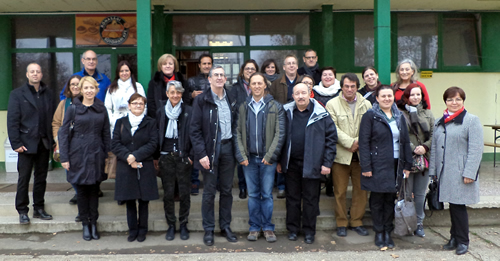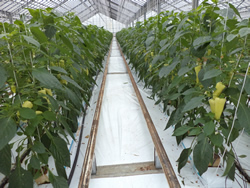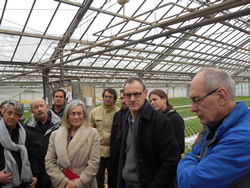Joint EPPO / COST-SMARTER Workshop on the Evaluation and Regulation of the use of Biological Control Agents in the EPPO Region
 |
Budapest, 2015-11-23/24
|
 |
Presentations | Conclusions and recommendations
Over seventy people from around the EPPO region and beyond gathered in Budapest on 23th November 2015 for a two day workshop to consider the evaluation and regulation of biological control agents. Many different regulations have a potential bearing on the import and release of organisms in new areas but in the EPPO region few of these are specifically drafted with biological control agents in mind. Different types of organisms may be used, or proposed, for control of different types of target pest raising different issues for the assessment and management of risks and benefits. There are also many possible interpretations of key words like 'indigenous' or 'invasive'. The result is a wide range of different practice around EPPO member countries, even when applying similar legislation to similar scenarios.

Participants during the technical visit - view more pictures >
This workshop was organised jointly between EPPO, SMARTER (an EU COST Action), IOBC, IBMA, CABI and the Hungarian Ministry of Agriculture. Presentations included brief summaries of practice in seven different EPPO countries and an explanation from our sister organisation, NAPPO, of arrangements in North America, where there is generally more experience in the use of classical biological control. A number of recent case studies were then explained in more detail, ranging from a decision on release of an insect for classical biological control of an invasive plant to the development of augmentative biological control options against an insect pest newly arrived in the region. The workshop then split into four groups with each group considering three out of four hypothetical scenarios (download the four case studies  ) and addressing the following questions:
) and addressing the following questions:
- Which legislation applies?
- Which international or regional standards are relevant?
- What additional information is needed to make a decision?
- In what format should that information be provided and by whom?
- Who carries out the analysis and using what methodology?
- Who evaluates the analysis?
- Who should make the decision and who should be consulted?
The conclusions and recommendations from the workshop will be referred to the decision making bodies of the different participating organisations for further consideration. The EPPO/IOBC Panel on Biological Control Agents, meeting in the same venue later that week, has already started to take forward some of the recommendations.
On the day following the workshop our hosts in the Hungarian Ministry of Agriculture organised a very interesting technical visit to a large glasshouse production company at Árpád-Agrár Zrt in Szentes, Szentlászló horticultural premises which uses ground water for its heating and a wide range of biological agents for its pest control.
PRESENTATIONS
|
Introduction
|
|
|
|
Heinz Müller-Schärer, COST-SMARTER
|
|
|
Josep Jaques
|
|
|
Lieselot Van der Veken, IBMA
|
|
|
Giuseppe Stancanelli, EFSA
|
|
|
|
|
Relevant regulations and experience of implementation
|
|
|
|
Martin Ward, EPPO
|
|
|
Gábor Tőkés, Géza Ripka, HU
|
|
|
Jana Collatz, Karin Burkhart, CH
|
|
|
Aino-Maija Alanko, FI
|
|
|
Demetra Gkilpathi, GR
|
|
|
Antoon Loomans, NL
|
|
|
Bénédicte Gautier, Philippe Reynaud, FR
|
|
|
Vlasta Knapic, Simona Mavsar, SI
|
|
|
Lieselot Van der Veken, IBMA
|
|
|
|
|
Regional and international co-ordination
|
|
|
|
Peter Mason, CA
|
|
|
Sam Bishop, GB
|
|
|
Andrei Orlinski, EPPO
|
|
|
|
|
Case studies with biological control agents of plants
|
|
|
|
Richard Shaw, CABI
|
|
|
Elizabete Marchante, H. Freitas, J. Hoffmann, H. Marchante, PT
|
|
|
Sybren Vos, Marco Pautasso, Mike Jeger, EFSA
|
|
|
Urs Schaffner, COST-SMARTER
|
|
|
Heinz Müller-Schärer, COST-SMARTER
|
|
|
|
|
Case studies with biological control agents of insect pests
|
|
|
|
Milka Glavendekic, RS
|
|
|
Fernanda Colombari, Gianluca Governatori, IT
|
|
|
Johanette Klapwijk, IBMA
|
CONCLUSIONS AND RECOMMENDATIONS
(download as pdf  ) )
Conclusions
- Introduction and use of a biological control agent is potentially subject to a wide range of different types of regulation and recommendations.
- Internationally these include the IPPC, the CBD (provisions on IAS and on ABS), and OECD guidance on biopesticides
- At EU level relevant regulations include those aimed at plant pests, invasive species, marketing of pesticides and protection of habitats
- The first three of these EU regulations have been recently amended, and further amendments to accommodate biological control agents are unlikely in the near future
- Implementation at national level varies considerably, even within EU
- Inappropriate implementation of regulations (the wrong regulation, or the implementation in a way which is not tailored to the specifics of use of biocontrol agents) risks losing the opportunity for significant benefits from increasing use of biological control agents for crop protection and for reducing environmental damage from invasive pests (including plants). For example it endangers the possibility of BCA making a significant contribution to the National Action Plans under the Sustainable Use Directive
- Evidence of real problems from use of properly authorised biological control agents is very limited – generally BCAs have demonstrated their safety over a long period
- Technically there is a strong case for an eco-regional approach to regulation because BCAs may spread across national borders
- EU Member States have not yet introduced tailored regulations for biological control agents at EU level despite opportunities to do so
- EPPO Member Countries have previously decided against establishing a ‘First Release Expert Group’ at EPPO level
- IBMA have recommended against regulating at EU level
- There is scope for ‘soft harmonisation’ at EU or EPPO level through more guidance and establishment of an independent expert review mechanism
Recommendations
- Guidance is needed on which regulations should be applied in which cases (e.g. the scenarios presented at this workshop). EPPO/IOBC and EU (SUD Steering Group) could have a role in this.
- Common definitions would be useful (e.g. 'indigenous')
- National authorities should be encouraged to establish effective co-ordinating mechanisms to ensure a coherent respond to requests to use and release BCAs (e.g. between authorities responsible for environment, agriculture and health regulation)
- Proposed releases of BCAs should be discussed early on with the national authorities in order to agree host test lists etc. in advance
- More harmonisation should be achieved through recognition and use of existing EPPO guidance, additional guidance where needed, sharing of information on applicable regulations and on specific applications for releases (subject to the need for commercial confidentiality) between regulators in neighbouring countries, and development of a form of “mutual recognition” between countries with similar conditions
- An independent expert review group for applications at European level should be explored again, building on EFSA’s experience at reviewing the evidence on release of a non-native BCA against an invasive acacia in Portugal
- A distinction should be made between agents expected to establish (normally introduced with the intention of classical biological control) and agents not expected to establish (normally introduced on a commercial basis as augmentative control)
- Decisions on import and release of BCAs should be made in the context of a background level of introductions of new organisms to the EPPO region and their spread within the region. Not all of that spread of organisms can be avoided – particularly within the EPPO region across land borders
- Potential use of biological control should be included in contingency planning for arrival of new pests in the EPPO region, so that some of the information needs and regulatory hurdles can be addressed in advance
- Some of this contingency planning should take place at a European level
- Fast track procedures should be considered for emergency situations
- The Euphresco research funders and managers network offers one way in which research on biological control options might be co-ordinated between countries to which a pest is native (or where it is well established) and countries to which that pest is likely to spread
- Analysis of a proposed release should include the environmental, economic and social benefits as well as risks including:
- benefits from reduced environmental damage by the target pest
- benefits from reduced use of other control options, including operator exposure and reduced MRL exceedences
- other benefits e.g. human health benefits from control of allergenic plants and pests
- Benefits and risks should be quantified where possible, even though there may be a large measure of uncertainty e.g. about the efficacy of a classical BCA
- Inclusion of benefits in the analysis requires some evidence of efficacy
- Information should be exchanged between national authorities on the spread and impacts of BCAs which have been released (with or without authorisation)
|




![]() ) and addressing the following questions:
) and addressing the following questions:


